When do you need to remove onions from the garden?

Many gardeners are engaged in onion cultivation. To get a good harvest, you should not only properly care for it, but also harvest it at a certain time. In this article, we will consider when it is necessary to remove onions from the garden, how to determine its maturity, when to dig out its different types, why it is not recommended to violate the rules for its harvesting.
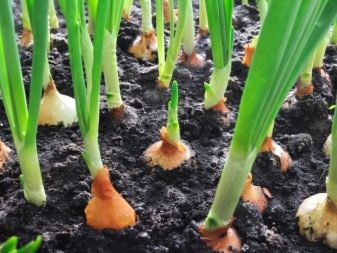
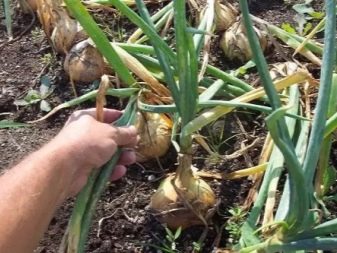
How to tell if the onion is ripe?
Onions are a popular vegetable and can often be found in home gardens. This vegetable has a rather pungent taste, as well as unique bactericidal properties. It is used to prepare various dishes. Growing onions will not bring much trouble, since they are unpretentious in terms of environmental conditions. But strong plants that already have a fully formed head cannot boast of keeping quality and excellent quality. To increase the shelf life of onions, you should correctly collect them from the garden, and also provide preparation for storage.
You can remove the onion from the garden only after it is fully ripe. Various factors affect the rate at which this vegetable ripens. This can be weather conditions, variety, top dressing and watering frequency. To determine the readiness of the onion for digging, you need to pay attention to the following external signs:
- the leaves become less saturated in color, begin to turn yellow (if the onion receives abundant watering, then the leaves begin to turn yellow much later, so you should not wait for the mandatory yellowing of the feather);
- 2-3 weeks before harvesting, the feather becomes sluggish, losing its original elasticity;
- the neck becomes thinner, elasticity is lost;
- the onions may break a few days before harvesting in the neck area, after which the leaves fall on the soil;
- after digging, the roots of the onion are shortened and dried up;
- the scales change in color, after which they begin to peel off.

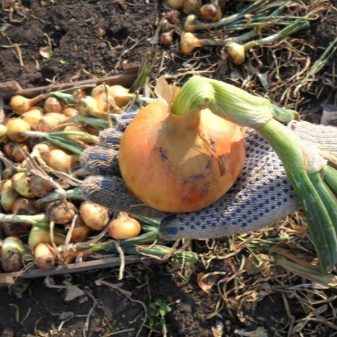
All of the above signs help to correctly determine the time when you need to dig out the onion. And this is very important, since overripe or unripe bulbs are only suitable for quick processing, because they are poorly stored.
Important! Usually onions are characterized by amicable ripening. If about 70% of the crop has signs of readiness for harvest, then you can proceed to digging up the entire onion plantation.
You should not only correctly determine the timing of harvesting from the garden, but also know how this is done correctly. Experienced gardeners recommend digging about a third of it about half a month before digging the onion, and also forget about watering. If weather conditions interfere with this, then you can cover the beds from the rain with a plastic bag. In general, the rules for collecting onions are simple. The main goal is not to damage the bulbs, as otherwise their shelf life will be significantly reduced. It is recommended to consider the following tips from experts:
- neatly prying the plants with a pitchfork is the best option for digging out the onions (if for some reason this option is not suitable, then it is better to pull out the bulbs by hand);
- it is better to pull each vegetable separately, since digging out several heads at the same time can damage them;
- if dirt has adhered to the bulbs, it must be carefully cleaned; it is strictly forbidden to use shaking or beating blows;
- the vegetable must be thoroughly dried, so it is laid out in the sun for several hours (to make it more convenient, it can be placed along the garden bed along the edge and only in one layer, it is advisable to turn the bulbs from time to time).
Important! Carefully dug onions are characterized by a long shelf life, while retaining their taste and useful properties.
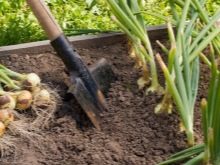
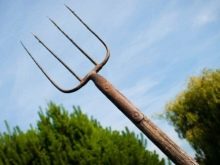
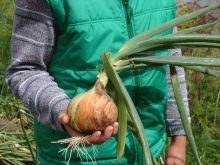
Auspicious days
You can usually harvest onions from the garden 3 months after planting. On average, the collection takes place at the beginning of August. Digging is necessary when the ground is dry. If it rains, then it is better to slightly shift the timing of the collection of onions. It is advisable to choose an auspicious day for digging up the harvest. It should be dry and sunny. If there is a slight breeze, then immediately when digging out the bulbs will already be dried. It is better to harvest the crop before lunchtime, then it will be able to dry out until the evening, which will increase the storage duration.
Some gardeners take into account the lunar calendar when choosing an auspicious day. It is recommended to dig the onion when the waning moon phase begins. The choice of the day is also influenced by the variety, namely:
- winter - June 3, 12, 25 and 26;
- leek - October 24, 28 and 29;
- onion sets - from 11 to 15 and 20 July, 1, 2, 18, 26, 27 and 29 August, 2, from 23 to 26 and 30 September.
Important! In order to choose the right number for collecting onions, it is recommended to take into account not only the lunar calendar, but also varietal characteristics, as well as the growing region.


When to dig up different species?
It is better not to stick to a specific date, since onions are planted on different days, so the dates can vary significantly. Many people advise planting onions during the flowering of bird cherry, but in a rainy summer there is no such possibility. Some gardeners do not attach much importance to the timing of planting onions, so they do it when they have free time.
Onion
The onion variety should be considered:
- early ripens up to 3 months;
- mid-season is desirable to collect in 3-4 months;
- late - from 4 months.
Important! The time of harvesting onions is influenced by the weather. If there are few sunny days in the region, while there is a lot of rain, then it will take more time to ripen. Usually in the northern regions and central Russia, mid-season varieties are planted, which are ideal for storage in the winter. Usually the time of their collection is August. But an early variety or one planted before winter is not suitable for storage. In the first case, it simply rots rather quickly, and in the second, it does not have time to ripen.

Spring
If spring onions are planted in warm soil (about 12 degrees at a depth of 50 cm), then the timing mainly varies depending on the growing region.
- Southern regions of Russia and Ukraine. Usually, planting takes place in the second half of April. Harvesting is desirable at the end of July. It should be remembered that a very hot summer negatively affects the quality of onions, because at soil temperatures above +70 degrees, onions can "cook". To save the harvest in small areas, tulle or lutrasil is used.
- Middle zone of Russia and Belarus. In these territories, planting is usually carried out in early May, but collection is already in early August.
- Moscow region. It is advisable to plan the harvest at the end of July or in the first half of August.
- Ural and northern regions. It is better to plant a vegetable in the second half of May, and pick it up in mid-August. If it often rains in the region in summer, then you can postpone the harvest, but no later than the beginning of September, since the first frosts will soon come.
Important! If spring onions are harvested in damp weather, then it is advisable to dry the heads thoroughly. It is recommended to leave them on a Russian stove or in an electric dryer for several hours, while keeping the temperature plus 50-60 degrees.
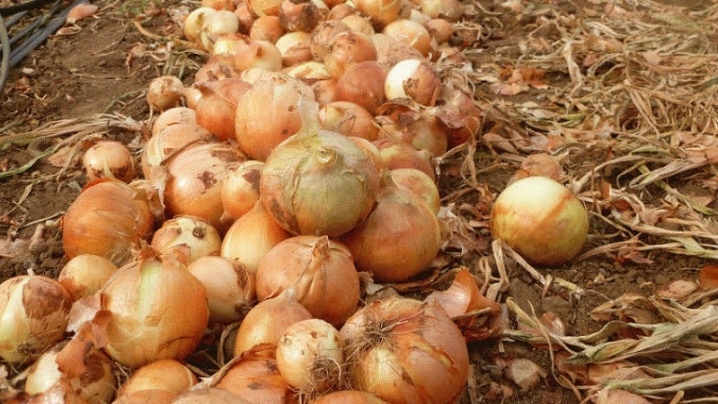
Winter
Winter onions are quite popular as they are usually planted in the fall. For planting, only onion sets are used, which are weak and small. It is better to refuse from strong and large sets, since the plant should not go to "shooting". Small onions have a small amount of nutrients, so they are not allowed to shoot arrows, but they survive autumn and winter well, gaining strength and energy. Already in the spring they give an excellent harvest.
The peculiarity of winter onions is that in the fall, poor quality seed is appreciated, since it will allow you to get an excellent harvest next year, in addition, it will not be able to be stored under standard conditions until spring. And high quality winter onions are cheaper. After the autumn planting, the onions are covered with sawdust, leaves and a variety of materials that will help to better endure the winter. When spring comes, planting needs loosening, watering, and top dressing. If the onion is planted before winter, then general criteria for assessing the ripening of this vegetable, for example, lodging a large number of feathers or assessing the scales of bulbs, will help determine the period of its collection.
Winter onions have clear advantages over other species. The main thing is that low-quality seed material can be used profitably, the early harvest period, as a result, a site is freed up for planting another vegetable. But not everything is perfect, since the cultivation of winter onions is largely dependent on nature.
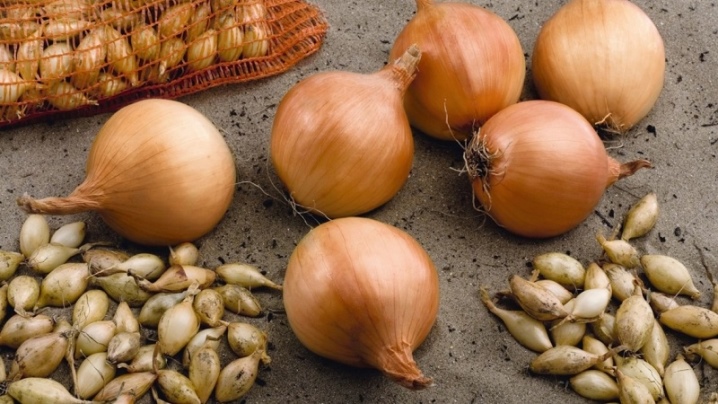
Shallot
This variety has a shorter growing season when compared, for example, with onions. Shallots are harvested at approximately the same time as onions (in July). If the crop is harvested in dry and windy weather, then it will be stored for a long time.
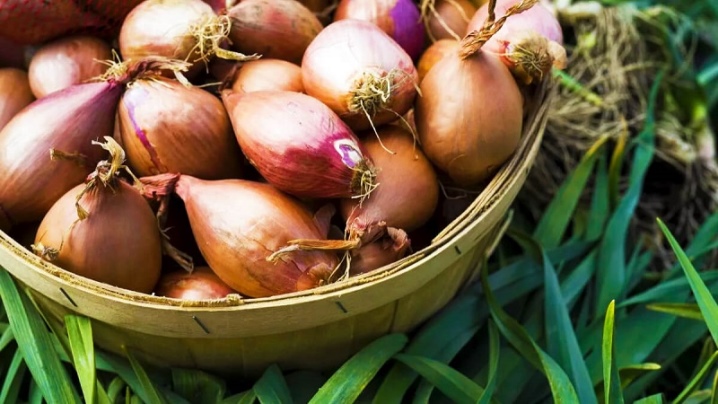
Leek
This variety does not form a turnip like the above species. Some varieties have a growing season of no more than 140 days. If you plant a leek in the spring, then the harvest is harvested in the fall. Leek has green feathers even in late autumn. It is difficult for inexperienced gardeners to determine its readiness for harvest, therefore it is recommended to dig it before the first frost, so that the stem of the plants will become thicker.

What happens if you break the cleaning rules?
There are different situations and various mistakes regarding the time when it is necessary to remove the onions from the garden. It is undesirable to dig up a vegetable that has not yet ripened, since it cannot be stored for a long time. Onions begin to deteriorate rather quickly in the following cases:
- if the neck has not dried out, then it forms the so-called "gate" through which both viruses and bacteria can enter;
- the cover scales have not yet formed on the bulbs, but they have already been dug up, as a result they do not have a protective layer;
- if the plants still have living roots that absorb nutrients, and they have already been dug out, then stress sets in.
Important! It should be noted that the presence of green feathers will allow onions dug out prematurely to ripen without soil. But such an onion cannot boast of a full-fledged mineral and vitamin complex. It has a shorter shelf life as it increases the likelihood of being infected by a virus or bacteria. If the bulbs are dug up later than necessary, then storage difficulties may occur. Overripe onions have already dried up protective scales, which generally fall off during harvest. As a result, the head remains open to various negative influences. In addition, re-growth of the root system is possible. In this case, nutrients go from the head to the roots, thereby weakening it. Further, children begin to form on it. Such onions are not suitable for winter storage. It is advisable to use it first.
It is recommended to dig up onions from the garden in the event that the plant has already entered the dormant stage. This means that the heads already have fully formed tissues, and the processes of renewal of life processes have not yet begun.
If you adhere to all the above recommendations regarding the time of harvesting onions from the garden, then you can get a tasty and healthy crop that will be perfectly stored until next year.

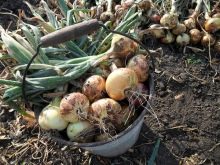
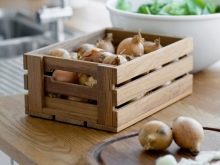













The comment was sent successfully.